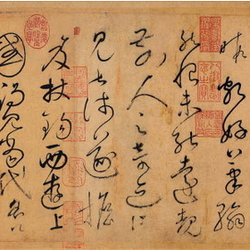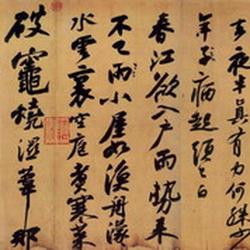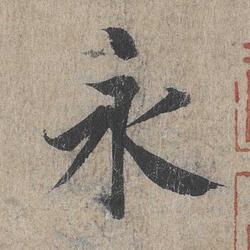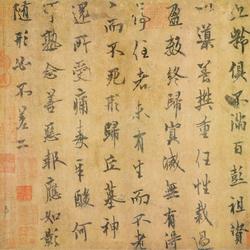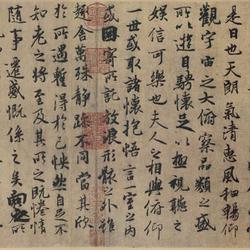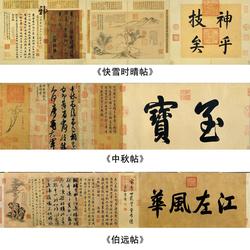Tang Dynasty - Yan Zhenqing's "Manuscript of Sacrifice to My Nephew" - the second best running script in the world
【Name】Manuscript of memorial ceremony for nephew
[Category] Running calligraphy
【Author】Yan Zhenqing
【Form】hemp paper
【Era】Tang Dynasty
[Original size] 28.2 cm in length and 75.5 cm in width
【product size】
[Current Situation of Cultural Relics] Taipei National Palace Museum
Overview of the main text of "Manuscript of Memorial to My Nephew":
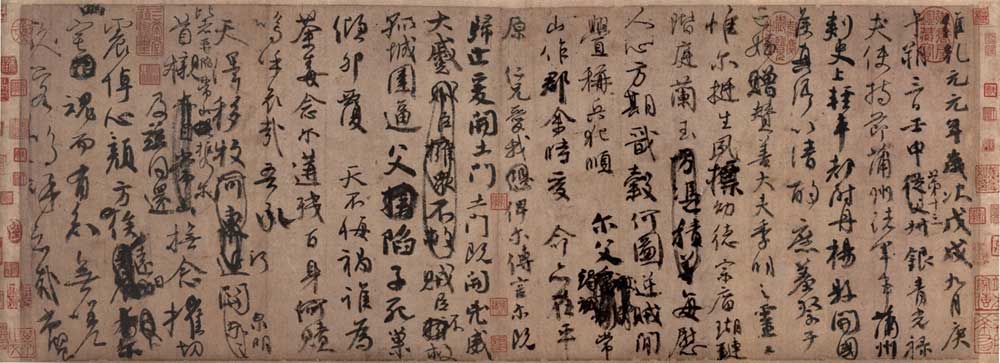
Details of the main post (from left to right):
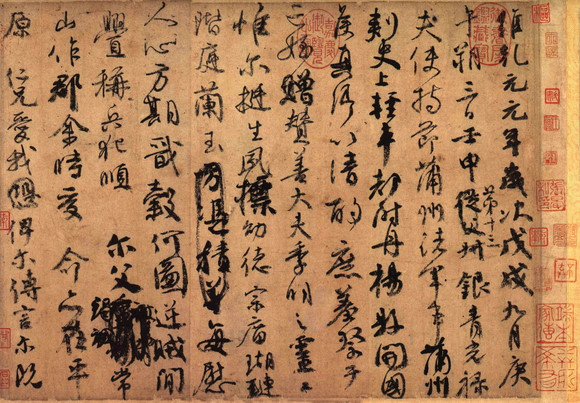
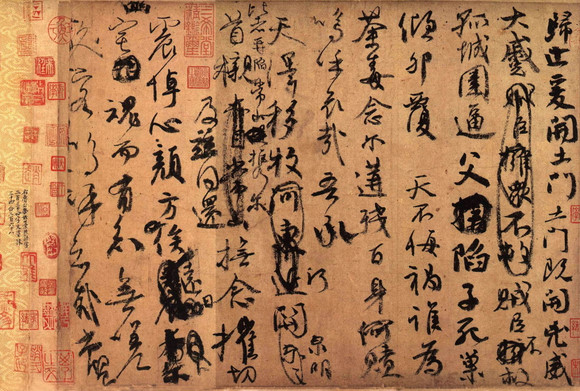
original:In the first year of Wei Qianyuan, on the third day of Renshen in the ninth month of Wuxu, Gengwu and Shuo, the thirteenth uncle, Yin Qingguang Lufu, envoy Chijie, Puzhou military officers, Puzhou governor, Shangqingche Duwei, Danyang County Zhenqing, the founding lord of the country, offered a memorial to his deceased nephew to praise the benevolent doctor Ji Ming:
You are still alive and well-behaved. The ancestral temple is decorated with orchid and jade. Every time you soothe people's hearts, you can go to the valley. Why should rebels and thieves provoke each other in a leisurely manner, while claiming to be soldiers and violating obedience? Your father is sincere and makes Changshan the county. The rest of the time I was ordered to stay in the plains. My dear, I love you, Beer said. When you return home, you will open the earth gate. Once the earth gate is opened, there is a fierce frown. The thieves and ministers did not save him, but the isolated city surrounded him. The father is trapped and the son dies, and the nest collapses and the eggs fall. If God does not regret the misfortune, who is responsible for the evil? I think you are disabled, how can you redeem your body? Alas!
I inherited Tianze and moved to Muhe Pass. If the spring is brighter, it will fall into Changshan again. I am bringing you your head and I will return it with you. The caressing and remembrance are devastating, and the heart is in mourning. When the sun is far away, Bu'er's house is quiet. The soul has knowledge, and it is a long-term guest without complaining. Alas!
【Description of work】
The full name of "Memorial to My Nephew Manuscript" is "Manuscript of Ji Ming's Nephew", which is one of the three major running script calligraphy scripts. It was written in the first year of Qianyuan of Tang Dynasty (758 AD). The bell has seals such as "Zhao's son, the Subaru family", "Daya", "Xianyu", "Shu", "Xianyu Shu's uncle and father", and "Xianyu". It was once collected by Xuanhe Neifu of the Song Dynasty, Zhang Yan of the Yuan Dynasty, Xian Yushu of the Yuan Dynasty, Wu Ting of the Ming Dynasty, Xu Qianxue of the Qing Dynasty, Wang Hongxu, and the Neifu of the Qing Dynasty. It is now in the collection of the National Palace Museum in Taipei.
"Manuscript of Memorial to Nephew" was written by Yan Zhenqing to commemorate Yan Jiming, his nephew who died in the Anshi Rebellion. In the 14th year of Tang Tianbao's reign (775), Anlushan rebelled. Yan Zhenqing, the governor of Pingyuan, contacted his brother Yan Gaoqing, the governor of Changshan, to launch an army to attack the rebels. In the first month of the following year, the rebel Shi Siming's troops captured Changshan. Yan Gaoqing and his youngest son Ji Ming were arrested and killed one after another. More than 30 members of the Yan family were killed. In the first year of the Qianyuan year of Emperor Suzong of the Tang Dynasty (AD 758), Yan Zhenqing ordered people to go to Hebei to look for Ji Ming's skull and bring it back, and wrote this memorial poem with tears that will leave a lasting legacy.
As one of Yan Shu's famous "Three Drafts" (the other two drafts are "Fighting for a Seat" and "Manuscript of Reporting to Uncle"), it has been included in the engravings of the Song, Ming and Qing dynasties, and has been imitated by many in the past dynasties. , constant praise.
In calligraphy creation, lyricism is the first difficulty. The eternal value of "The Manuscript of Memorial to My Nephew" lies in its frankness and sincerity. It is a model of using sincere emotions to drive the pen and ink, and under passion, regardless of clumsiness, and free to create as one pleases. The distinctive personality and the unique form are unprecedented in history. They are typical examples of calligraphy creations that describe aspirations, feelings, and expressions. They reflect the bold and forward-looking spiritual character and the unparalleled courage and mind of an artist. The emotional intensity contained in the works so powerfully shocks the hearts of every viewer that they have no time to take into account the superficial effects of the formal composition. This is the typical structure of natural beauty.
Emotion is an art trick that everyone knows, and calligraphy creation is especially about true emotion and deep thinking. The wonderful pen that shakes the reader's heart must be based on true emotion, and the high and far-reaching realm must be achieved through deep thinking. The so-called creation of artistic value means that the general form contains independent existence that cannot be contained by ordinary structures. It is both a physical existence and a personal existence. Reflected in calligraphy creation, it is often a one-time acquisition that cannot be replaced by other things. "The Manuscript of Sacrifice to My Nephew" is exactly such a work. It is the only form of existence under the control of special emotions. What plays a decisive role here is sincere feelings and passionate emotions. It is like a bolt of lightning that cuts through the night sky, fleeting and irretrievable.
In human affairs, only true feelings can move people, especially literature and art. In the Roman era, Longanas also emphasized this point when he proposed the five sources of sublime style in his classic literary and art theory masterpiece "On the Sublime". He said: "The first and most important is the solemn and great thought, and the second is the solemn and great thought. The second is strong and exciting emotions." He also said: "The important role of passion in creation and style is enough to make the entire structure magnificent."
Calligraphy creation is based on emotion and is driven by the mind. The vivid images and profound meanings in the works are the result of integrating emotion into the calligraphy. It cannot be caused" (Liu Yongji's "Ci Lun"). Only with extreme emotion, talent, and extreme thinking can "love be expressed freely and things be revealed." Especially those who touch the emotions of things unconsciously can create vivid, touching, novel and wonderful works. Therefore, the most excellent works must be based on deep feelings. Although the pen is simple, it is thoughtful and artistic, and the appearance may be ugly, but the emotion is true. The degree of touching is determined by the intensity of emotion contained in the work.
"Manuscript of Memorial to My Nephew" is a masterpiece poured out of sincere emotions, a sonata of the soul, a voice of great sorrow and anger, and an immortal masterpiece condensed with blood and tears. The unconscious expression technique in the state of "forgetfulness" makes the works produce extremely beautiful artistic effects. "The drunkard's intention is not to drink", "Xiangzhuang's sword dance is to Pei Gong", he is not writing, but describing the grief and indignation in his heart, he is not engaged in artistic creation, but talking to himself affectionately, The words were finished, the work was finished, and a masterpiece that no one, including himself, could ever repeat was produced. This is the secret to successful creation, and it is also an example of a breakthrough that occurred in an extraordinary moment after a long period of exploration.
The quality of its lines is strong and comfortable, blending seamlessly with the heart-wrenching thoughts and feelings, which is particularly commendable. This is the most difficult technique in calligraphy. In the history of Chinese calligraphy, only this work is the most powerful and smooth. The so-called "dry autumn breeze moistens the spring breeze", only this work can match it. Xian Yushu of the Yuan Dynasty commented on this as the second running script in the world. "The best running script in the world" has been taken first by Wang Xizhi's "Lanting Preface", so this work had to take second place. In fact, "The Manuscript of Sacrifice to My Nephew" should be regarded as the best running script in the world. "Manuscript of Sacrifice to My Nephew" is an example of helpless method, direct expression of the heart, and incomparable real natural beauty. Although "Lanting Preface" is also supremely beautiful, after all, it is more artificial beauty than natural beauty.
【About the Author】
Yan Zhenqing (709-785), courtesy name Qingchen, was born in Langya (now Linyi, Shandong) and was a famous calligrapher in the Tang Dynasty. Throughout his life, he served as the supervisory censor, palace censor, Pingyuan prefect, minister of the Ministry of Industry, minister of the Ministry of official affairs, and official censor. He was granted the title of "Gong of Lu County" and was a veteran of the four dynasties of Xuanzong, Suzong, Daizong, and Dezong. Xiang was known in the official circles as a righteous man, so much so that he sacrificed his life for the Tang Dynasty and became a benevolent person. The family is well-educated and specializes in rulers and tablets. His regular script is dignified and majestic, and his running script is vigorous and unique. He is known as "Yan style". Yan style calligraphy has had a profound impact on the development of calligraphy art in later generations. Yan Zhenqing not only established a towering monument in the history of calligraphy, but his noble character was also admired by later generations. Both his people and his books are models. Yan Zhenqing's calligraphy and inscription works include "Duobao Pagoda Induction Stele", "Ode to Dongfang Shuo's Painting", "Yan Qin Li Stele", "Ode to the Zhongxing of the Tang Dynasty", "Magu Immortal Altar", "General Pei's Poems", "Seat Competition", etc. The ink works include "Manuscript of Memorial to Nephew", "Tie of Liu Zhong", "Tie of Huzhou" (Biography), "Tie of Self-report", etc.

